Script for Transpersonal ai-EMDR Somatic Bridge (Floatback) into the 4th Transpersonal Prong
Scripted protocol for a transpersonal, somatic bridge from psychedelic experiences into early attachment material within EMDR therapy, with prompts and BLS guidance.
Read MoreComparing the effectiveness of online therapy versus in-person therapy in youth: Protocol for a non-inferiority randomized controlled trial (Trials)
In a randomized controlled trial, this protocol would aim to compare the results of online Acceptance and Commitment Therapy (ACT) and EMDR therapy to in-person treatment.
Read MoreEditorial retraction (Journal of EMDR Practice and Research)
An editorial retraction notice.
Read MoreExploring the relationship between breastfeeding and psychological well-being after traumatic childbirth: A secondary analysis of the PERCEIVE study data (Journal of Psychosomatic Obstetrics & Gynecology)
This study investigates associations between breastfeeding outcomes and psychological well-being in women with traumatic birth experiences, utilizing data from the PERCEIVE trial, which assessed EMDR therapy effectiveness on PTSD after childbirth trauma.
Read MoreEarly eye movement desensitisation and reprocessing (EMDR) therapy for traumatic birth experience: Treatment for maternal postpartum post-traumatic stress disorder (PTSD) (Evidence-Based Nursing)
EMDR therapy for traumatic birth experience and maternal postpartum PTSD.
Read MoreExploring EMDR: An innovative approach with Posner Paradigm to reprocessing negative memories in a non-clinical sample (Frontiers in Psychiatry)
This study explored the underlying mechanisms of EMDR, with results suggesting that the mechanism of attention shifting is what plays a critical role in the therapeutic process.
Read MoreTrauma-informed training as a path to intergroup readiness: A mixed-methods evaluation of EMDR education in a shared society context (Frontiers in Psychology)
This mixed-methods study examined how participation in a shared EMDR training program influenced professional self-efficacy, intergroup openness, and reconciliation readiness among therapists working within a conflict-affected society.
Read MoreReframing dental anxiety: Cognitive behavioral therapy and its role in phobia treatment—A narrative review (Diseases)
This narrative review synthesizes recent evidence on CBT applications for phobia management, with particular emphasis on dental settings, and highlights emerging approaches such as EMDR therapy.
Read MoreApplicability and effectiveness of group EMDR therapy for forced migrants (European Journal of Psychotraumatology)
This retrospective pilot study evaluates the feasibility, acceptability, and effectiveness of a modified EMDR GTEP protocol tailored for migrant populations at a regional psychotrauma centre in Europe.
Read More



